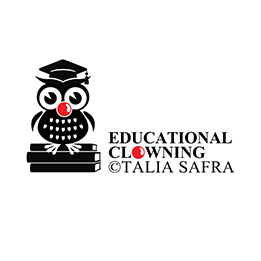The Educational Clowning Center
By Talia Safra’s Method
When a child in a hospital meets a clown, he meets an imaginary friend who allows him to be brave, to control what is happening to him and to choose who he would like to be.
Educational clowning brings the art of playing and humor to schools to improve personal identity, to reduce stress and to create a sense of belonging.
In recent years, Medical Clowning has been incorporated into the health system and has become an inseparable part of it.
Research that has been carried out in this field has proven that Medical Clowning has a positive influence and affects motivates patient to receive treatment.
Clowning within the school framework answers the emotional, social and educational needs that arise from the educational system and adapts itself to this system.


Empowerment and integration
Educational Clowning Center
by Talia Safra’s method

Social-emotional learning and needs
To Offer the gift of Educational Clowning language as a way of changing the reality

Educational
Clown
Creates an alternative reality
and empowers the child
ליצנות חינוכית
The educational clown and the education system
The educational clown is an unconventional mediator between the student and the system, between the student and his friends and between the student and himself.
The students’ emotional, social and academic challenges, along with processes of identity building and self-image, make the period of schooling stressful and anxious. All of these directly affect the school climate and students’ learning.
The educational clown enables a new way of communication wherever he goes, communication that stems from creativity, humor, empathy, listening, working collaboratively and expanding boundaries.
The main principles of educational clowning:
• Reducing tension between the student and the educational framework
• Expanding the student’s ability to build identity and belonging
• Creating a new language within the school that combines humor, sincerity, intimacy, and empowerment.
The role of the educational clown
- Integrate in classes and in the breaks in order to create an atmosphere of openness, and to create a bridge between the student’s inner world and the school world.
- Create positive and open communication between students and teachers and between students and themselves and improve the school climate.
- Be a source of emotional support, independent of place and time for students and school staff.
- Locate students in situations of difficulty and risk, social isolation, emotional problems, etc., and use professional tools from the field of educational clowning to deal with these situations. Such as: resolving conflicts through humor and play, instilling habits and discipline in a non-judgmental or authoritative way, empowering students and expanding their positive visibility in school.
- Set an example of “different” and allow students to accept diversity and discern and experience the social power of difference to contribute
“Educational clowning emerged from the medical clowning field as a new form of therapeutic clown care tailored for the school system. The educational clown is an indispensable part of the education system and validates students and teachers alike.”
The educational clown training process
All the educational clowns at the Educational Clowning Center by Talia Safra’s method received academic training through the training program of the Center for Educational Clowns in collaboration with and under the academic supervision of Bar-Ilan University.
As part of the studies, the educational clowns trained in several main courses:
- Therapeutic clowning
- Special education and its integration in schools
- S.E.L- Social Emotional Learning
- Educational clowning
- In addition to practical training within the school grounds




